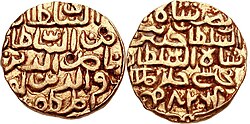Nasiruddin Nasrat Shah
Thank you for being part of the Bharatpedia family! 0% transparency: ₹0 raised out of ₹100,000 (0 supporter) |
| Nasiruddin Nasrat Shah | |
|---|---|
| Sultan of Bengal Shah E Bangal the right hand of the caliphate, the defender of the Commander of the Faithful | |
 | |
| Reign | 1519 - 1533 |
| Predecessor | Husain Shah |
| Successor | Firuz Shah IV |
| Died | 1533 |
| Spouses | Daughter of Ibrahim Lodi |
| Issue | Firuz Shah IV |
| Father | Husain Shah |
| Religion | Sunni Islam |
Nāsir ad-Dīn Naṣrat Shāh (Bengali: নাসিরউদ্দীন নুসরত শাহ, Persian: ناصر الدین نصرت شاه; r. 1519–1533), also known as Nusrat Shah, was the second Sultan of Bengal belonging to the Hussain Shahi dynasty.[1] He continued with his father's expansionist policies but by 1526, had to contend with the Mughal ascendency in the Battle of Ghaghra. Simultaneously, Nasrat Shah's reign also suffered a reverse at the hands of the Ahom kingdom. The reigns of Alauddin Husain Shah and Nasrat Shah are generally regarded as the "golden age" of the Bengal Sultanate.[2]
Early life and background[edit]
Nasrat was born into an aristocratic Sunni Muslim family in the Bengal Sultanate. His father Alauddin Husain Shah was the first Sultan of the Hussain Shahi dynasty and the father of eighteen sons and at least eleven daughters. Among Nasrat's siblings were Danyal and Mahmud.[3]
Nasrat Shah married a daughter of Ibrahim Lodi, who was the Pashtun ruler of the neighbouring Delhi Sultanate.[4]
Reign[edit]
After his father's death in 1519, Nasrat rose to the throne as Nasiruddin Nasrat Shah. Trailing the policies of his father, Nasrat Shah expanded the Sultanate territory early on in his reign and Khalifatabad emerged as an important mint-town.[5] Following Babur's invasion of India, Mahmud Lodi and his Afghan confederates fled to Bengal for safety. In 1527, Babur despatched an envoy to Bengal in order to deduce Nasrat Shah's attitude towards Mughal ascendency and collect some information regarding Bengal. Nasrat Shah did not respond and imprisoned the envoy. However, Nasrat Shah later negotiated peace deals and freed the envoy, in order to send gifts to Babur. Babur was pleased with the response; describing Nasrat as one of the great rulers of the Indian subcontinent, praising Bengali soldiers for their gunnery and navy, and recognised the loyalty of Bengalis for their leader.[6]
After being pestered by the Afghans, the Mughals declared war against them and their Bengali allies. Attempting to defeat the Afghans on the way, the Mughals proceeded towards Bengal. Babur took control of Tirhut before stopping at Buxar, where he requested Bengal to dismiss their troops camped at the banks of the Ghaghara. Nasrat Shah's refusal led to the Battle of Ghaghra, taking place on 6 May 1529, in which the Mughals fought the Afghans and Bengalis. The Mughal Empire were victorious, and their territory extended to Ghaghara's eastern bank in Bihar though they did not penetrate Bengal.[7] Nasrat Shah maintained Bengal's status as an independent nation.[8]
He completed the building of Baro Shona Masjid in Gauḍa (city) in 1526 AD. 8
See also[edit]
References[edit]
- ↑ M.H. Syed, History of Delhi Sultanate, pp.237-238.
- ↑ Chowdhury, AM (2012). "Nusrat Shah". In Islam, Sirajul; Miah, Sajahan; Khanam, Mahfuza; Ahmed, Sabbir (eds.). Banglapedia: the National Encyclopedia of Bangladesh (Online ed.). Dhaka, Bangladesh: Banglapedia Trust, Asiatic Society of Bangladesh. ISBN 984-32-0576-6. OCLC 52727562. Retrieved 24 February 2024.
- ↑ Chowdhury, AM (2012). "Husain Shah". In Islam, Sirajul; Miah, Sajahan; Khanam, Mahfuza; Ahmed, Sabbir (eds.). Banglapedia: the National Encyclopedia of Bangladesh (Online ed.). Dhaka, Bangladesh: Banglapedia Trust, Asiatic Society of Bangladesh. ISBN 984-32-0576-6. OCLC 52727562. Retrieved 24 February 2024.
- ↑ Sen, Sailendra (2013). A Textbook of Medieval Indian History. Primus Books. pp. 120–121. ISBN 978-9-38060-734-4.
- ↑ Akhtaruzzaman, Muhammad (2012). "Khalifatabad". In Islam, Sirajul; Miah, Sajahan; Khanam, Mahfuza; Ahmed, Sabbir (eds.). Banglapedia: the National Encyclopedia of Bangladesh (Online ed.). Dhaka, Bangladesh: Banglapedia Trust, Asiatic Society of Bangladesh. ISBN 984-32-0576-6. OCLC 52727562. Retrieved 24 February 2024.
- ↑ Abdul Karim (2012). "Tuzuk-i-Baburi". In Islam, Sirajul; Miah, Sajahan; Khanam, Mahfuza; Ahmed, Sabbir (eds.). Banglapedia: the National Encyclopedia of Bangladesh (Online ed.). Dhaka, Bangladesh: Banglapedia Trust, Asiatic Society of Bangladesh. ISBN 984-32-0576-6. OCLC 52727562. Retrieved 24 February 2024.
- ↑ Bhuiyan, Golam Kibria (2012). "Babur". In Islam, Sirajul; Miah, Sajahan; Khanam, Mahfuza; Ahmed, Sabbir (eds.). Banglapedia: the National Encyclopedia of Bangladesh (Online ed.). Dhaka, Bangladesh: Banglapedia Trust, Asiatic Society of Bangladesh. ISBN 984-32-0576-6. OCLC 52727562. Retrieved 24 February 2024.
- ↑ Erskine, William (1854). A History of India Under the Two First Sovereigns of the House of Taimur, Báber and Humáyun. Longman, Brown, Green, and Longmans.
| Preceded by Alauddin Husain Shah |
Sultanate of Bengal Hussain Shahi dynasty 1519–1533 |
Succeeded by Alauddin Firuz Shah II |

